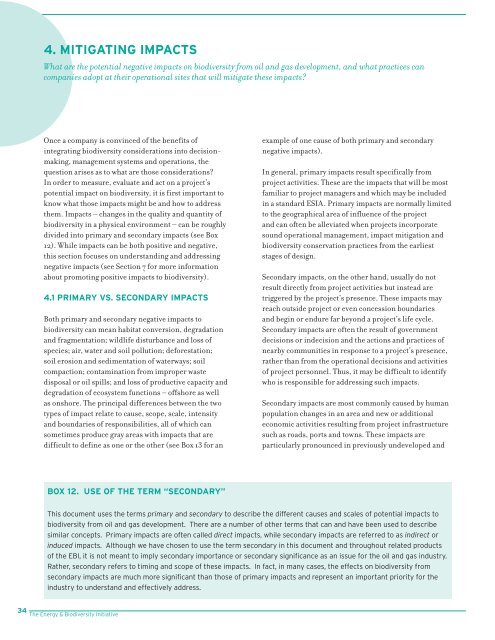Integrating Biodiversity Conservation into Oil and Gas ... - EBI
Integrating Biodiversity Conservation into Oil and Gas ... - EBI
Integrating Biodiversity Conservation into Oil and Gas ... - EBI
You also want an ePaper? Increase the reach of your titles
YUMPU automatically turns print PDFs into web optimized ePapers that Google loves.
4. MITIGATING IMPACTS<br />
What are the potential negative impacts on biodiversity from oil <strong>and</strong> gas development, <strong>and</strong> what practices can<br />
companies adopt at their operational sites that will mitigate these impacts?<br />
Once a company is convinced of the benefits of<br />
integrating biodiversity considerations <strong>into</strong> decisionmaking,<br />
management systems <strong>and</strong> operations, the<br />
question arises as to what are those considerations?<br />
In order to measure, evaluate <strong>and</strong> act on a project’s<br />
potential impact on biodiversity, it is first important to<br />
know what those impacts might be <strong>and</strong> how to address<br />
them. Impacts – changes in the quality <strong>and</strong> quantity of<br />
biodiversity in a physical environment – can be roughly<br />
divided <strong>into</strong> primary <strong>and</strong> secondary impacts (see Box<br />
12). While impacts can be both positive <strong>and</strong> negative,<br />
this section focuses on underst<strong>and</strong>ing <strong>and</strong> addressing<br />
negative impacts (see Section 7 for more information<br />
about promoting positive impacts to biodiversity).<br />
4.1 PRIMARY VS. SECONDARY IMPACTS<br />
Both primary <strong>and</strong> secondary negative impacts to<br />
biodiversity can mean habitat conversion, degradation<br />
<strong>and</strong> fragmentation; wildlife disturbance <strong>and</strong> loss of<br />
species; air, water <strong>and</strong> soil pollution; deforestation;<br />
soil erosion <strong>and</strong> sedimentation of waterways; soil<br />
compaction; contamination from improper waste<br />
disposal or oil spills; <strong>and</strong> loss of productive capacity <strong>and</strong><br />
degradation of ecosystem functions – offshore as well<br />
as onshore. The principal differences between the two<br />
types of impact relate to cause, scope, scale, intensity<br />
<strong>and</strong> boundaries of responsibilities, all of which can<br />
sometimes produce gray areas with impacts that are<br />
difficult to define as one or the other (see Box 13 for an<br />
example of one cause of both primary <strong>and</strong> secondary<br />
negative impacts).<br />
In general, primary impacts result specifically from<br />
project activities. These are the impacts that will be most<br />
familiar to project managers <strong>and</strong> which may be included<br />
in a st<strong>and</strong>ard ESIA. Primary impacts are normally limited<br />
to the geographical area of influence of the project<br />
<strong>and</strong> can often be alleviated when projects incorporate<br />
sound operational management, impact mitigation <strong>and</strong><br />
biodiversity conservation practices from the earliest<br />
stages of design.<br />
Secondary impacts, on the other h<strong>and</strong>, usually do not<br />
result directly from project activities but instead are<br />
triggered by the project’s presence. These impacts may<br />
reach outside project or even concession boundaries<br />
<strong>and</strong> begin or endure far beyond a project’s life cycle.<br />
Secondary impacts are often the result of government<br />
decisions or indecision <strong>and</strong> the actions <strong>and</strong> practices of<br />
nearby communities in response to a project’s presence,<br />
rather than from the operational decisions <strong>and</strong> activities<br />
of project personnel. Thus, it may be difficult to identify<br />
who is responsible for addressing such impacts.<br />
Secondary impacts are most commonly caused by human<br />
population changes in an area <strong>and</strong> new or additional<br />
economic activities resulting from project infrastructure<br />
such as roads, ports <strong>and</strong> towns. These impacts are<br />
particularly pronounced in previously undeveloped <strong>and</strong><br />
BOX 12. USE OF THE TERM “SECONDARY”<br />
This document uses the terms primary <strong>and</strong> secondary to describe the different causes <strong>and</strong> scales of potential impacts to<br />
biodiversity from oil <strong>and</strong> gas development. There are a number of other terms that can <strong>and</strong> have been used to describe<br />
similar concepts. Primary impacts are often called direct impacts, while secondary impacts are referred to as indirect or<br />
induced impacts. Although we have chosen to use the term secondary in this document <strong>and</strong> throughout related products<br />
of the <strong>EBI</strong>, it is not meant to imply secondary importance or secondary significance as an issue for the oil <strong>and</strong> gas industry.<br />
Rather, secondary refers to timing <strong>and</strong> scope of these impacts. In fact, in many cases, the effects on biodiversity from<br />
secondary impacts are much more significant than those of primary impacts <strong>and</strong> represent an important priority for the<br />
industry to underst<strong>and</strong> <strong>and</strong> effectively address.<br />
34 The Energy & <strong>Biodiversity</strong> Initiative
















![[PDF] Community Development Toolkit - CommDev](https://img.yumpu.com/48616495/1/184x260/pdf-community-development-toolkit-commdev.jpg?quality=85)
